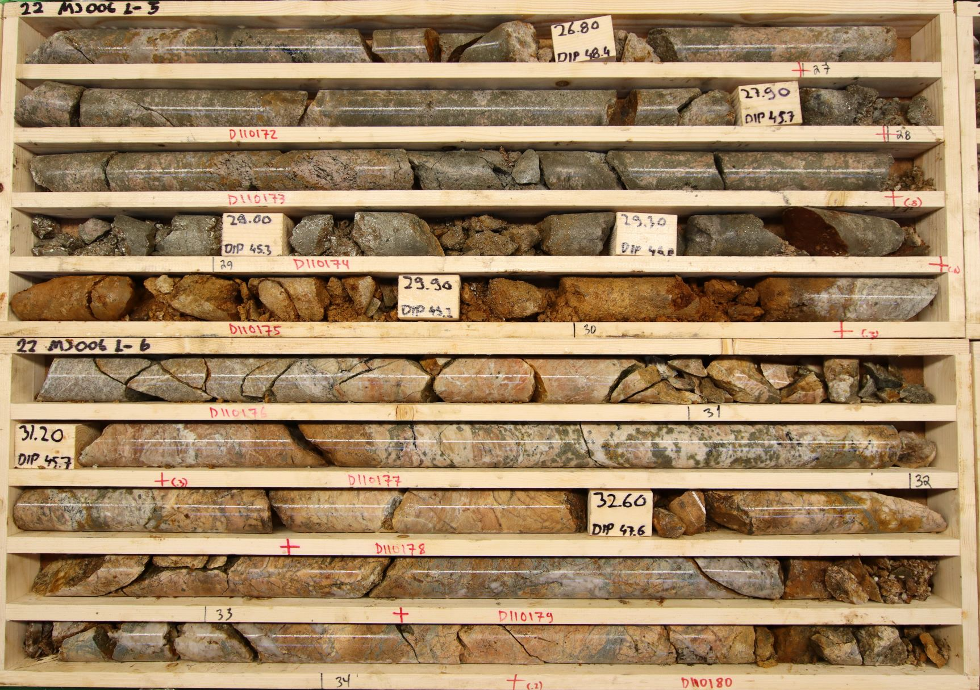SODANKYLÄ, FINLAND / ACCESSWIRE / September 6, 2022 / FireFox Gold Corp. (TSX.V:FFOX)(OTCQB:FFOXF)("FireFox" or the "Company") reports additional analyses from the recent drill program at the Company's 100%-held Mustajärvi Gold Project in Lapland, Finland. FireFox previously reported its best drill intercept yet from Mustajärvi, a 13.85-metre interval of drill hole 22MJ006 that averaged 14.39 g/t gold beginning only 24.2m down hole (see Company news release dated July 13, 2022). A subsequent program of screen fire assays of the highly mineralized interval confirmed that the mineralization is remarkably consistent, but the tests also identified coarse gold in one of the samples (Table 1).
HIGHLIGHTS FROM SCREEN FIRE ASSAYS OF 13.85 METRE HIGH-GRADE INTERVAL IN 22MJ006
- One sample from 25.05 to 26.00 metres depth returned a total gold grade of 439 g/t
- This sample contained 423 milligrams of coarse gold
- This bonanza grade sample was part of a field duplicate pair:
- The duplicate twin contained total gold of 15.85 g/t
- If all the screen fire results were incorporated into the broader high-grade interval, it would average 28.74 g/t over 13.85 metres
- Most of the interval exhibited excellent consistency between original fire assay and screen fire assays
- FireFox is working with its consultants and service providers to better understand and characterize the coarse gold at Mustajärvi
"The high-grade gold at Mustajärvi comes with its own special challenges, but the team has done an excellent job implementing a rigorous quality assurance protocol. These screen fire assay results remind us that this system contains significant coarse gold, and any noteworthy drill intercept may contain more gold than we first estimate," commented Carl Löfberg, CEO of FireFox Gold. "The gold system in the East Target comes right to surface and we see evidence for more than one direction of structural control. We look forward to bringing the drill back to follow-up, as these shallow intercepts are open in several directions."
The Company's consulting geochemist and quality control expert, Mary Doherty1, remarked in her evaluation of the new drilling data from Mustajärvi, "The Firefox sampling, preparation and analytical procedures are very thorough and carefully thought out. The one interval with extremely high gold suggests the presence of coarse gold which is not unexpected and is well characterized. Precision for the other gold assays in the drill hole examined is very good at 7% precision and < 4% bias between sample groups."
FireFox maintains an ongoing quality assurance program that includes screen fire gold assays on the high-grade intervals encountered at Mustajärvi. In this case, the team selected 8 samples from the 13.85-metre interval for screen fire gold assay. These samples all contained more than 10 g/t gold, as reported from an initial 50-gram fire assay and confirmed by triplicate 50-gram gravimetric "overlimit" fire assays.
As an additional component of its quality assurance program, FireFox designates approximately 3% of drilling samples as field duplicates. One of the field duplicates fell within this highly mineralized interval. In this instance, the other half of the sawed core is submitted blindly to the lab as a check of the total variability of gold, including that caused by the geological sample medium plus sample preparation and analysis. This resulted in the entire drill core being processed for the 0.95-metre interval in question. Hence, the discovery that this interval contained a coarse gold fragment (a "nugget").
Native gold tends to be malleable, which means it may not be ground or reduced in size when subjected to pulverizing in a standard lab preparation procedure. The screen fire assay procedure (see details below) evaluates this component of unpulverized material for gold by passing the entire 1,000-gram sample through a 106-micron (Tyler 150 mesh) screen. Gold and other material that has not been sufficiently pulverized will be retained on the screen, then this entire "plus fraction" is fire assayed, reporting the contained gold in milligrams.
During the screen fire process, the assayers determined that there were 423 milligrams of coarse gold in the sample, a significant part of the 23.2 grams of material collected in the plus fraction. Interestingly, the fine fraction of material, which did pass through the screen, assayed consistently around 16 g/t gold. The weighted average of the gold in the fine fraction plus the gold in the coarse fraction results in a calculated total gold value of the sample of 439 g/t.
Table 1: Complete Listing of Gold Assays in High-Grade Interval from Drill Hole 22MJ006
Sample ID | From (m) | To (m) | Au FA/AA | Au FA/Grav ("Overlimits") | Au Screen FA** | ||
|
|
|
| #1 | #2 | #3 |
|
| D110166 | 24.15 | 25.05 | >10.0 | 16.85 | 17.35 | 17.15 | 17.40 |
| D110167 | 25.05 | 26.00 | >10.0 | 16.75 | 17.00 | 16.35 | 15.85 |
| D110168* | 25.05 | 26.00 | >10.0 | 18.70 | 18.20 | 18.20 | 439 |
| D110171 | 26.00 | 27.00 | >10.0 | 18.85 | 19.05 | 19.20 | 18.40 |
| D110172 | 27.00 | 28.00 | >10.0 | 15.85 | 15.85 | 15.65 | 16.00 |
| D110173 | 28.00 | 28.80 | >10.0 | 18.65 | 18.00 | 18.70 | 17.90 |
| D110174 | 28.80 | 29.80 | >10.0 | 59.10 | 59.80 | 60.20 | 63.0 |
| D110175 | 29.80 | 30.30 | 1.205 |
|
|
|
|
| D110176 | 30.30 | 31.30 | 2.90 |
|
|
|
|
| D110177 | 31.30 | 32.30 | 6.27 |
|
|
|
|
| D110178 | 32.30 | 33.20 | 6.41 |
|
|
|
|
| D110179 | 33.20 | 34.20 | >10.0 | 14.20 | 14.65 | 14.30 | 11.05 |
| D110180 | 34.20 | 35.00 | 5.86 |
|
|
|
|
| D110181 | 35.00 | 36.00 | 9.43 |
|
|
|
|
| D110182 | 36.00 | 37.00 | 8.55 |
|
|
|
|
| D110183 | 37.00 | 38.00 | 5.34 |
|
|
|
|
* - Sample is a field duplicate of D110167, each sample is half drill core representing 25.05 - 26.00 metres | |||||||
** - Full screen fire assay procedure details are provided below, this value is total gold calculated from assays of the coarse and fine fractions. | |||||||
Significance of Coarse Gold at Mustajärvi
Coarse gold is something for which explorers must plan when drilling an orogenic gold system. However, visual logging will never identify all coarse gold in drill core or rock samples. Despite abundant high-grade gold assays, FireFox geologists believe they have recognized visible (coarse) gold in only three drill holes so far on the Mustajärvi Project, most notably in the first hole of the 2021 drill program (see Company news releases dated April 15, 2021 & June 17, 2021). Two of the three drill holes with likely visible gold were in the Northeast Target, and one hole in the East Target may have contained very small grains of visible gold (22MJ018). There was no such report in the log from 22MJ006. As noted, FireFox has rigorous procedures in place to help assure quality samples and the application of appropriate sample preparation and analytical procedures. The consistency and precision of the gold assays in this interval within 22MJ006 confirm that most of the gold in the East Target is fine-grained or in a mineral phase that is relatively homogeneous in the host rock.
Coarse gold occurs in isolated particles, blebs, wires, or inclusions that cannot be quantitatively estimated. The random element of coarse gold dictates that more is present in a mineral system than will ever be identified during drilling. Therefore, once it has been identified on a project, it is incumbent on the technical team to study and characterize the occurrences. This information may be used in the future to build a statistical model to support resource calculations. Based on that kind of work, a qualified person may elect to cap extremely high-grade assays in a resource model. The knowledge that coarse gold exists in a deposit implies that any significant gold intercept is subject to some uncertainty as to the actual contained gold grade.
FireFox's quality control consultant has recommended that the Company maintain its current sampling procedures, laboratory method selection, and quality assurance protocol. As an extra measure of caution, she also recommended that the Company implement additional cleaning sand during sample preparation between samples within zones identified as likely to be high-grade. The wash sand can be assayed for gold to assess possible carryover between samples.
The Company also plans to work with its consultant and certain expert service providers to initiate another study to rigorously characterize the coarse gold in the high-grade zones at Mustajärvi. The exact nature of the follow-up study will remain confidential as it may constitute a competitive advantage for the Company in its ongoing work. Findings from the study will be evaluated and released, likely in 2023.
Geology and Geochemistry of the High-Grade Drill Intercept
Most of the gold mineralization at Mustajärvi occurs in volcaniclastic or tuffaceous rocks (Sodankylä Group) that occupy the northern footwall of a sheared contact with mafic volcanic and ultramafic rocks of the Savukoski Group to the south. A corridor along the northeast-striking shear zone has been shown by FireFox drilling to be albite-altered with variable silica and sericite for more than 2.0 kilometres. Gold occurs in at least three significant pods or clusters associated with quartz-carbonate-tourmaline-pyrite (QCTP) veins of variable width or with more intense alteration and disseminated pyrite (including semi-massive to massive pyrite). The three zones of drill-indicated gold (so far) are called the Central Zone, the Northeast Target, and the East Target. The most recent drill results have come from the East Target (Figure 1).

Figure 1 - Mustajärvi East Target Drilling On Magnetics Base Map
In this part of the East Target, FireFox geologists have logged the host unit as tuffites of intermediate composition. The sequence in drill hole 22MJ006 is pervasively altered by albite with variable but intense silica and sericite. There is increased pyrite from approximately 24.5 metres through approximately 36 metres downhole (Figures 2 and 3). The strongest gold values in the mineralized interval are associated with bands or clots of semi-massive to massive pyrite, which is sometimes oxidized in the shallow portions of these holes. The zone is also cut by modest QCTP veins with molybdenite. Structures are frequently in evidence, based on intense fracturing, open space, and intense oxidation.
Gold mineralization has been drilled at Mustajärvi along more than 2.0 kilometres of the Mustajärvi Shear Zone (MSZ). The mineralization has been consistent in its primary geochemical association: bismuth, tellurium, molybdenum, cobalt, nickel, and selenium. There is also low-level silver, copper, lead, zinc, arsenic, antimony, and rhenium. The altered shear zone is typically depleted in arsenic, copper, and zinc with only local minor enrichment in these elements with high gold. The 13.85 metre high-grade gold interval in 22MJ006 contains some of the highest molybdenum (757 ppm) and tellurium (274 ppm) geochemistry yet drilled at Mustajärvi.
One element of the geochemistry may be related to the consistency generally seen in the gold-mineralized intervals from Mustajärvi. Gold is closely associated with tellurium in all the drilling to date on the project. FireFox has seen gold within complex telluride minerals under microscope examination, both as free mineral grains and within pyrite. Gold has also been observed within the mineral molybdenite. Telluride minerals are known to behave in a much more brittle fashion than native gold and electrum, meaning that gold telluride minerals are more likely to be effectively reduced in size during pulverization. This behaviour could account for high-grade gold samples with good repeatability. The rare coarse native gold and electrum would account for the coarse particles captured by the screen fire assay procedure.

Figure 2 - Photo of drill core (sawed) from hole 22MJ006 - 24m to 30m down hole. (Click HERE for full sized image)

Figure 3 - Photo of drill core (whole) from hole 22MJ006 - 27m - 34m down hole. (Click HERE for full sized image)
Methodology & Quality Assurance
The core was transported from the rig to the Company´s core storage facility in Sodankylä, where FireFox's exploration team conducted the geological and geotechnical logging and selected the assay intervals. Assay intervals were generally 1 metre but in some circumstances were modified according to lithological boundaries and other factors. FireFox geologists maintained chain of custody and sampling procedures according to best industry practice and with due attention to quality assurance and quality control, including sampling field duplicates and insertion of certified standard and blank samples.
FireFox team members transported the samples to an ALS sample prep lab in Sodankylä. The samples were sawed then crushed to -2 mm, split and pulverized into 1kg pulps, before being shipped to the ALS facility in Rosia Montana, Romania for gold by fire assay of 50 gm aliquots with AAS finish (method Au-AA24). Samples assaying above 10 g/t gold are automatically re-assayed by a 50 gm fire assay with gravimetric finish (method Au-GRA22). At FireFox's request, these overlimit assays were completed in triplicate in order to evaluate the homogeneity of the gold in the prepared samples. Other elements, altogether 48, were measured after four-acid digestion by ICP-AES and ICP-MS (method ME-MS61) at the ALS facility located in Loughrea, Ireland.
In this case, FireFox geologists requested that the samples exceeding 10 g/t gold be re-analysed by a 1,000-gm screen fire assay (Au-SCR24) on a new pulp collected from coarse reject. The following is the laboratory procedure as provided publicly by ALS Geochemistry:
The sample pulp is passed through a 106 µm (Tyler 150 mesh) stainless steel screen. Any material remaining on the screen (+) 106 µm is retained and analyzed in its entirety by fire assay with gravimetric finish and reported as the Au (+) fraction. The material passing through the screen [(-) 106 µm fraction] is homogenized and two sub-samples (50g) are analyzed by fire assay with AAS finish (Au AA26 and Au AA26D). The average of the two AAS results is taken and reported as the Au (-) fraction result. All three values are used in calculating the combined gold content of the plus and minus fractions.
The gold values for both the (+) 106 and (-) 106-micron fractions are reported together with the weight of each fraction as well as the calculated total gold content of the sample.
Calculations:
Au-avg(ppm) = (Au-(1) + Au-(2)) / 2
AuTotal(ppm) = ((Au-avg(ppm) * Wt.Minus(g)) + (Au+(ppm) * Wt.Plus(g))) / (Wt.Minus(g) + Wt.Plus(g))
It should be noted that FireFox audited the local ALS sample preparation lab during 2021 and found it to be operating to a high standard. Additional follow-up interactions with the lab after receipt of these results also identified no problems with lab procedures. The consistency of the gold between the original assays and the screen fire assays, in most cases, is a good indication that the sample preparation is likely not introducing contamination. This is because screen fire assays are prepared from the original crushed reject material, which means that rock was not passed through the grinding mills in the first place. The pulverization process is almost always the source of carryover contamination.
ALS Laboratories is a leading international provider of assay and analytical data to the mining industry. All ALS geochemical hub laboratories, including the Irish facility, are accredited to ISO/IEC 17025:2017 for specific analytical procedures. The Firefox QA/QC program consists of insertion of certificated standard material and blanks into the analytical batches, none of which showed significant deviations from recommended values in the reported data.
1 - Mary Doherty is an exploration geochemist and certified professional geologist with more than 35 years' experience in mining and mineral exploration. She has recently held positions as Exploration Technologies Group Executive and Chief Geochemist for Newmont Goldcorp Mining Corp. and North American Business Development Manager for ALS Minerals. Ms. Doherty is currently an adjunct professor of exploration geochemistry at the Colorado School of Mines and principal of International Geochemical Consultants LLC. She is engaged by FireFox as a consultant but is otherwise independent of the Company.
Patrick Highsmith, Certified Professional Geologist (AIPG CPG # 11702) and director of the Company, is a qualified person as defined by National Instrument 43-101. Mr. Highsmith has helped prepare, reviewed, and approved the technical information in this news release.
Dr. Sven Hönig, Certified European Geologist (EFG EurGeol Title # 1789) and General Manager of Exploration for the Company, is a qualified person as defined by National Instrument 43-101. Dr. Hönig has supervised the field work reported herein and has helped to prepare and approved the technical information in this news release.
About FireFox Gold Corp.
FireFox Gold Corp is listed on the TSX Venture Stock Exchange under the ticker symbol FFOX. FireFox also trades on the OTCQB Venture Market Exchange in the US under the ticker symbol FFOXF. The Company has been exploring for gold in Finland since 2017 where it holds a huge portfolio of prospective ground.
Finland is one of the top mining investment jurisdictions in the world as indicated by its multiple top-10 rankings in recent Fraser Institute Surveys of Mining Companies. Having a strong mining law and long mining tradition, Finland remains underexplored for gold. Recent exploration results in the country have highlighted its prospectivity, and FireFox is proud to have a Finland based CEO and technical team.
For more information, please refer to the Company's website and profile on the SEDAR website at www.sedar.com.
On behalf of the Board of Directors,
"Carl Löfberg"
Chief Executive Officer
CONTACT:
FireFox Gold Corp.
Email: info@firefoxgold.com
Telephone: +1-778-938-1994
Forward Looking Statements
The information herein contains forward looking statements that are subject to a number of known and unknown risks, uncertainties and other factors that may cause actual results to differ materially from those anticipated in our forward-looking statements. Factors that could cause such differences include changes in world commodity markets, equity markets, the extent of work stoppage and economic impacts that may result from the COVID 19 virus, costs and supply of materials relevant to the mining industry, change in government and changes to regulations affecting the mining industry.
Forward-looking statements in this release may include statements regarding: the intent to conduct additional drilling; the belief as to the location of the most prospective gold targets; the location of targets for future drill programs; and the current and future work program, including the extent and nature of exploration to be conducted in 2022. Although we believe the expectations reflected in our forward-looking statements are reasonable, results may vary.
The forward-looking statements contained herein represent the expectations of FireFox as of the date of dissemination and, accordingly, are subject to change after such date. Readers should not place undue importance on forward-looking statements and should not rely upon this information as of any other date. FireFox does not undertake to update this information at any particular time except as required in accordance with applicable laws.
SOURCE: FireFox Gold Corp.
View source version on accesswire.com:
https://www.accesswire.com/714729/FireFox-Gold-Encounters-Significant-Coarse-Gold-at-the-East-Target-on-the-Mustajrvi-Project-Finland







